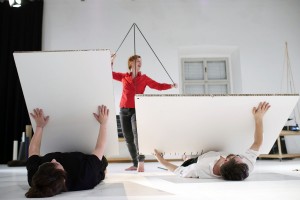29 February – 12 March 2016
Embodied Diagrams
Tanzquartier, Vienna, Austria
During the Spring Lab, we – Nikolaus Gansterer, Mariella Greil and Emma Cocker – staged an intensive residency laboratory in collaboration with Tanzquartier Wien. In dialogue with a team of international critical interlocutors including Alex Arteaga, Lilia Mestre, Werner Mobius, Jörg Piringer, Christine de Smedt and other guests, this research residency focused on gesturing with and towards the experience of vitality within the process of live exploration, putting epistemologies, relational processes and the potentials of embodiment through diagrammatic practice under scrutiny. The Spring Lab involved different phases of activity:
Part I
Phase I was an intensive period of 4 days working closely with sputnik Christine de Smedt to put pressure on the ‘ventilation of language’, drawing on the conversational transcripts from our project as a live material for playful appropriation and reworking, close reading and collective speech acts. Whilst our previous investigations had explored the repetition or recurrence of the word ‘like’ within our transcribed conversations – for example, used as both a comparative and associative device – our attention now shifted to address the terms ‘when’, ‘where’ and ‘how’, using these as a means for searching through and editing our transcripts towards a list of questions, even an experimental script.
How do I move beyond the realm of description? How do you decide what to do next? How do you approach the other in the space? How is the nature of invitation? How do you repeat? How do we work against it and resist? How does language work? How do I write in space? How do you harness that and make that part of a process? How do you articulate that? How do you attend to the micro and the macro? How do we map that? How do we think this in terms of time? How do you mark it? How do you know? How does this connect to mode of address? How do you invite somebody into an experience? How can you condense this? How far do we need to go? […]
The focus on ‘how’ questions gave rise to a more explicitly enquiry-driven direction of exploration that we tentatively named the Figure of Trans-questing. This figure involved selecting a specific ‘how’ or ‘when’ question from the list distilled from the transcripts and adopting this as provocation or imperative for the next phase of exploration.
Part II
All key researchers working with our guests Werner Moebius (sound artist) and Jörg Piringer (sound poet) to further test the experimental permutational score system that has been in development since Summer 2015, conceived as a means for bringing our three core modes of practice (A: Attention; B: Exploration; C: Conversation) into choreographic relation. Through Live Exploration together our intent was to test the different facets of our newly expanded score system – which now included D – Witnessing, as well as the recently conceived Figure of Trans-questing. One area of focus for working with Jörg and Werner has been in relation to the acoustic qualities, the role that sound plays within the Live Explorations specifically addressing its capacity for sharpening, focusing or redirecting attention, akin to how the (A) Attentional Practices and (C) Conversational Practices function.
Part III
This lab marked a significant transition for the project, the movement towards a more directed focus on the publication and presentation of our research findings through both page and performance. Through extended dialogue we began a process of diagramming and discussing the different facets of our research enquiry, identifying potential areas of practice in relation to a future publication, with the support of designer Simona Koch who we will now work with to further explore ways of transforming our knowledges into book form. We asked: How are our different enquiries interconnected? What materials do we have already? How could these materials be ordered and interlinked? Can the book become a score in itself? As part of this discussion, we were able to discern a rhizomatic system of interrelated ‘choreo-graphic figures’ that have emerged through our research process including: the Figure of Ordering and Emptying Out (of Beginning and Getting Started); the Figure of Resonance and Dissonance; the Figure of Wavering Convergence; the Figure of Ventilating Language; the Figure of Circulating Momentum; the Figure of Transquesting; the Figure of Shared Vibration; the Figure of Becoming Material; the Figure of Closure. Over the coming days, we worked intensively with documenter, Viktor Jaschke, attempting to capture key moments (using still and moving image) from within three specific Figures – the Figure of Resonance and Dissonance; the Figure of Ventilating Language; the Figure of Becoming Material – considering how this material might function within the context of both page-based and web-based publication or as an autonomous video documents.
Part V
Our attention over these next days shifted from publication to performance, exploring different ways for sharing our enquiry and its findings with wider publics through the staging of Live Exploration as a witnessed event. We asked: How do we prepare our witnesses? What modalities of interaction can we invite? Working with Alex Arteaga, we identified a list of key words that we proposed to share with our witnesses as a way of sensitizing them to the core preoccupations within our research. Specifically, we identified key words to reflect the core areas of our current enquiry: (1) Figure/Figuring – liminal, passage, opening, immanence; (2) Notion of Notation >< Notation of Notion – sign, meeting, sensitization, form; (3) The Qualities of Howness – poesis, vitality, attunement, inflection; (4) Embodied Diagram – articulation, co-relation, correlation, becoming; (5) Translation – practice, receptivity, redundancy, unbelonging. On 10 March, we – the key researchers, along with Jörg Piringer and Werner Moebius – shared a Live Exploration with a group of invited critical witnesses (Arno Boehler, Susanne Granzer, Jeanette Pacher, Helmut Ploebst, Andreas Spiegl). Our intent was to test our permutational score, as well as investigate whether the introduction of key words and other diagrammatic forms of viewing device facilitated a deeper public engagement with our enquiry. On 11 March, we shared a second Live Exploration with a different group of witnesses – including Karin Harrasser, Krassimira Kruschkova, Gabrielle Cram, Walter Heun, alongside a wider public ‘audience’), which was followed by a period of feedback and discussion. Central to this phase of our investigation has been the challenge of ‘making public’ the liveness of exploration and its moments of discovery and revelation. How do we invite ‘others’ into the experience? What modalities of attention need to be prepared? How do we ‘call’ this ‘public’, since the terms audience and participant fail to fully account for the nature of phenomenal encounter or co-production of experience that we hope arises through the ‘making public’ of our Live Exploration. Within this phase of exploration we were able to further distil and refine our permutational score into the following fields of practice departing from our original ABC configuration: (A) Attention; (C) Conversation; (F) Figures; (W) Witness.


